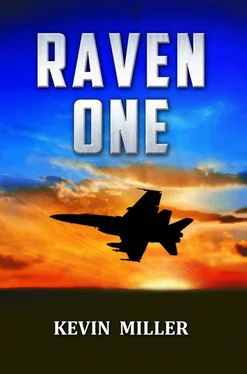Wilson got up and went to a J-dial phone circuit to call the CAG office. The Ops officer, known as Bucket, answered.
“Yes sir, Flip here in Air Ops. Four-zero-six is low state and the tankers are dry or sour. They’re riggin’ the barricade.”
“Yeah, we just got the word. I’m tryin’ to find CAG… We’ll be right there.”
“I’m tryin’ to find my XO.”
“Is your skipper airborne?”
“Yes, sir… my recommendation is to trap Sponge now or fly alongside and eject.”
“OK, Flip, got it, thanks,” Bucket said as he hung up. Wilson went back to his place next to XO Johnson, aware that the eyes of the other aviators were on him. Wilson dialed Ready 7 and Prince Charming answered. “Ready Seven, Lieutenant Howard.”
“Prince, Flip, where’s the XO?”
“He hasn’t come in yet.”
“Find him and get him to Air Ops now !” Wilson ordered.
“Yes, sir.”
“Tell him they’re gonna barricade Sponge.”
“Holy shit!”
“Find Dutch and Smoke, maybe they can help the LSOs up there. Break out the premishap plan.”
“Aye, aye, sir. Dutch is up there waving now,” Prince said.
Wilson realized he was powerless to do anything. The Captain had decided to barricade Sponge, and that was that. He looked at Commander O’Shaunessy hunched over his desk with the phone receiver in one ear. He saw the PLAT crosshairs moving slowly relative to the S-3 on glide slope. Cajun is airborne. CAG isn’t here. XO isn’t here. Even if they were, he realized, they couldn’t overturn the Captain’s decision. The book says when a Hornet gets to 2.0 at night, you barricade him. The captain was nothing if by the book. Rig the barricade! Yes, sir! Aye, aye, sir!
The barricade was a nylon web net made of heavy-duty nylon bands that hung down vertically from a steel cable rigged across the landing area. It was held up by two great stanchions that lifted it some 20 feet above the deck. This allowed the aircraft to make a normal carrier approach with the barricade net stopping the aircraft. Typically, the arrestment ended with significant damage, and the pilot had no option to eject once the aircraft was caught. The pilot shut down the engines on LSO command as the aircraft crossed the ramp, which further reduced the scant 10-foot hook-to-ramp clearance. The aircraft had to roll into the net with little drift — drift would cause the aircraft and the net to veer over the side or into the jets parked alongside the foul line. Too high was disaster. If the top loading strap were to snag the hook or landing gear, the aircraft would be slammed to the deck with back-breaking force, and the fiery wreckage would slide down the angle and into the water. And once inside a certain point subjectively determined by the LSO, there was no way to wave-off. It was rare for the Navy to barricade an airplane, maybe once a decade. And when it happened, it was an event felt throughout the fleet. Hey, did ya hear Valley Forge barricaded a Hornet last night?
I can’t believe we are doing this, thought Wilson. Night, dog-squeeze weather, pitching deck barricade! If all works well, if the barricade is rigged in time, if the deck steadies out, if we don’t steam into a squall, if Shakey or Stretch give him the right sugar calls, if Sponge flies a solid pass, everything will be fine. Just trap him! He has one, maybe two looks. If he doesn’t get aboard, then eject alongside.
Wilson wondered if Sponge knew what was happening. He got up from the bench to review the NATOPS manual for barricade procedures when he saw his XO standing at the entrance to the room. Still in his flight gear, Saint scowled at him and cocked his head in a motion to come over. Saint then led them into the back office.
“Yes, sir,” said Wilson.
“Mister Wilson, what the hell is going on?”
“Sponge couldn’t plug because the tanker was sour, fuel streaming from the hose. The other tanker was dry from tanking all the bolters and wave-offs. They’re gonna barricade Sponge.”
“Did you recommend that?”
“No, sir… the Captain made the call. I recommended they trap him normally in these conditions. He’s got two looks.”
“And if not aboard he’s out of gas. Then what?”
“Controlled ejection alongside,” Wilson replied, keeping his face expressionless as he held the XO’s gaze.
Saint looked down at the deck with tight lips steadying himself on a desk as the ship took a roll. The overhead creaked under the strain. He snapped his head up, eyes narrow with contempt.
“I expected more from my Operations Officer.”
“Sir?”
“Why is that nugget out there in these conditions? I expect my Ops Officer to write a schedule that reflects the expected weather. But I don’t expect him to then go and countermand an order of a Captain more than twice his seniority! Unsat.”
Wilson felt his upper body tighten.
“Sir, the Skipper signed the schedule almost 24 hours ago — before we knew what we would be facing tonight, before we knew we would be over 200 miles from any divert. Any senior officer in Air Wing Four could have broken the chain today with a recommendation to stop flying.” He paused and lowered his voice. “Any flight lead could have ensured his wingman came down with sufficient fuel for any contingency instead of showing up here at minimum fuel. Any flight lead could have sent his lower-state wingman down first. And any pilot could have gotten out of the gear clean so his wingman could trap.”
The XO’s eyes narrowed even more, and he forcibly exhaled through his nose. Wilson knew right away he had overstepped several boundaries. Back-talk to commanders, even when justified, was never career-enhancing. He waited for the blast. When Saint just glared at him, apparently unsure of how to counter, Wilson decided to change course.
“I didn’t countermand anything, sir. I made a recommendation. Sponge has to fly a solid pass, and if he doesn’t hit the barricade clean, he probably doesn’t get a chance to punch if he needs to. My recommendation is made and noted. Our squadronmate is in trouble, and I made a call. Now I have to get back — unless you want to take over, sir.”
At that moment the familiar sound of an S-3 catching an arresting wire filled the space, and through the armored steel of the flight deck, they heard the muffled voice of the Boss on the loudspeaker. “Rig the jet barricade. We’ve got a low-state Raven ! Ready Cat 3 for the alert Texaco! Get movin’!”
The overhead fluorescent light shone down on the Raven pilots as they looked at each other, unyielding and firm. Either one apologizing for the exchange was unthinkable.
“Get up there,” Saint finally said.
At least he kept his eyes on me , Wilson thought, before his thoughts turned back to Sponge. As soon as he returned to his place next to The Big Unit, but before he could sit down, O’Shaunessy motioned Wilson over to the console and handed him the radio handset. “Tell Jasper we’re gonna barricade him in about five minutes. Do you guys have a procedure for that?”
Sponge breathed deeply as he flew away from the ship eight miles aft. Two thousand pounds… I’ve got a little over 20 minutes at this fuel flow . He wondered why they were vectoring him out here and keeping him at angels two. When he looked over his left shoulder, he could make out a cluster of lights in the distance… Valley Forge… and home. He desperately wanted to be aboard her. A bolt of lightning flashed nearby and for an instant the ship was illuminated in a bluish light, before darkness surrounded it again. During Sponge’s short aviation career, he had already become accustomed to being at low fuel states. Judging from their ready room conversations, the old guys like Flip and Weed loathed them as much as he did. Sweating fuel was part of life when a Hornet pilot was at sea.
Читать дальше












